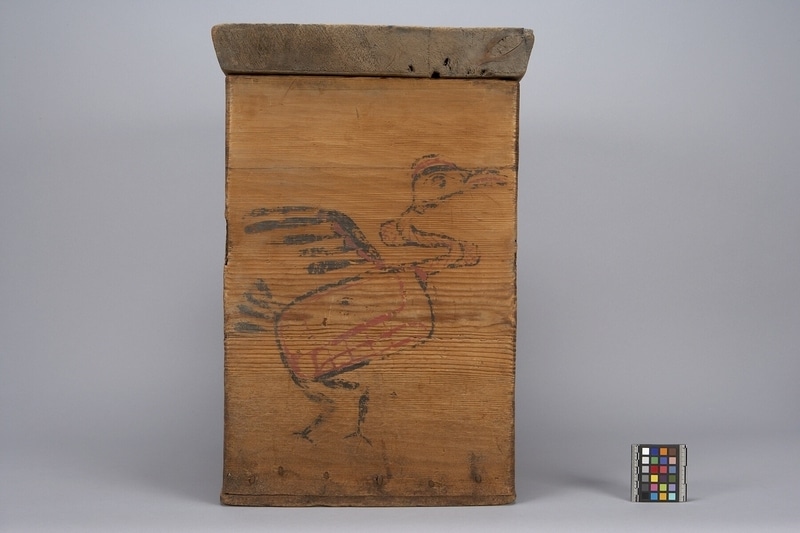Bentwood Box Item Number: A8229 a-b from the MOA: University of British Columbia




Description
Bentwood box with four painted panels, and an unpainted removable lid (part b) with sides that bevel inwards towards the bottom. Two of the opposite sides of the box have similar designs formed in continuous black primary form lines and red secondary lines. On an adjacent side is a bird figure with an ovoid body painted in black and red. The last side is painted with two ovoids joined by a line, all in red.
History Of Use
Bentwood boxes were used primarily for storage of food, implements, clothing and valuables. They were also used for cooking and serving food. They sometimes served as furniture or room dividers. They were also used as trade goods or gifts, and were symbols of wealth and prestige. Boxes for ceremonial purposes were usually more highly decorated than those for everyday use.
Cultural Context
storage; trade; status; ceremony
Iconographic Meaning
On side four the wings, tail, long neck and beak suggest a seabird, perhaps a heron. This may represent a crest of a Tsimshian matrilineal clan.
Specific Techniques
Bentwood, or kerfed-corner, containers are constructed by a process unique to the Northwest Coast Aboriginal peoples. The carver begins with a single straight-grained plank of red cedar, or sometimes yellow cedar, spruce, or yew. The surface of the plank is finished with chisels, adzes, and knives; in earlier times, it was smoothed further with sandstone or dried sharkskin. Then three parallel kerfs, or grooves, are carved out at measured points across the width of the board, at right angles to the long edge. The kerfs, which will become three corners of the box, allow the board to be steamed until the wood fibres are softened, and then carefully bent to form a box with symmetrical sides. The final corner, as well as a fitted base, are joined and fastened with pegs (through drilled holes) or laced with spruce root or twisted cedar withes (branches). Storage boxes also have fitted lids of cedar, hollowed from the inside. Finally, painted compositions may be applied to the completed box and shallow carving added to bring the forms into relief. A well-made bentwood box is watertight. Historically, most boxes were used to store preserved foods and material goods; plain cooking boxes could be used to steam or boil food by adding water and heated stones.
Item History
- Made in British Columbia, Canada
- Collected in Kitsegukla, British Columbia, Canada
- Owned by Wilhelm Helmer before November 10, 1962
- Received from Wilhelm Helmer (Seller) and H. R. MacMillan (Funding source) on November 10, 1962
What
Who
- Culture
- Gitxsan
- Previous Owner
- Wilhelm Helmer
- Received from
- Wilhelm Helmer (Seller) and H. R. MacMillan (Funding source)
Where
- Holding Institution
- MOA: University of British Columbia
- Made in
- British Columbia, Canada
- Collected in
- Kitsegukla, British Columbia, Canada
When
- Ownership Date
- before November 10, 1962
- Acquisition Date
- on November 10, 1962
Other
- Condition
- fair
- Accession Number
- 0086/0003 a-b